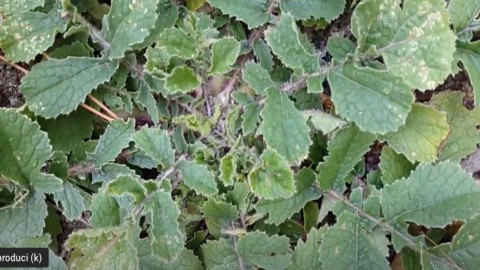Ermulata, ambuazza, almuràccia, rave or chima-chima. are just some of the many names of wild radish in Sardinia, a medicinal plant rather appreciated in cooking, cosmetics and folk medicine. It is often confused with horseradish and classic radish even if the size and taste of the leaves make it much closer to chicory or broccoli, however presenting a milder flavor and aroma. Its ideal environment is the countryside, where it flowers from March to June no more than 1.400 meters above sea level, growing spontaneously around roadsides, banks, vegetable gardens, ruins or uncultivated land. However, great care must be taken when, during the harvest, in the wheat fields, the seeds of the wild radish mix with the cereal, giving rise to the intoxication better known as radish.
With its pungent taste, more than the classic one, the wild radish is a rustic plant also known in our country as radish, radish or ramiracce. Characterized by shaggy and slightly hairy leaves and small, pale flowers on a branched stem. The flower is typically pale yellow to straw yellow, although white specimens may be found.
Unlike the root, prized by the Romans for its aphrodisiac qualities, wild radish has always been considered a weed,"cibus illiberalis” according to Pliny the Elder, due to its bad smell when cooked, while Cato disclosed its cultivation techniques. However, radish is an unmistakable plant, loved and appreciated throughout the country for its good texture even after cooking, making it a very filling and long-lasting vegetable. So much so that the grandmothers used it to enrich soups and soups.
Cultivation
Usually the wild radish it is not cultivated much given its shape: the leaves reach 30 centimeters in height and the root can weigh 500 grams. With the boom of the organic garden, even the cultivation of wild radishes has increased.
The cultivation technique of raspberry it is very easy, as it grows well everywhere and in every climate, it requires a deep soil rich in organic substances. Furthermore, it can be grown all year round, both in the ground and on the balcony of the house. It is an edible plant capable of adapting to any type of temperature, even if in summer it is advisable to keep it in partial shade so as not to subject it to direct sunlight. It grows on any type of soil: as long as it is well drained and possibly non-clayey. For best results it is also recommended to add a little compost mixed into the soil to give the plant an extra boost.
It is sown in rows directly on the ground, making sure that the different seedlings have sufficient space to grow in the ground without suffocating each other: each row must be about 40 centimeters apart from each other and each plant in the same row must distance from each other about 20 centimeters. The first vegetables begin to appear after 5 months, so it is recommended to sow in June or, at the latest, towards the beginning of August.
Then you have to weed the ground near the seedlings and carry out the so-called "tamping" putting earth on. This procedure will serve to make the roots more tender. If the soil is clayey and well drained, it is advisable to sow seeds in slightly raised beds, at least 15 cm high. The leaves are best picked in spring as they become bitter in summer.
There are several varieties of the wild radish: that summer which must be sown in winter, while the round radish in winter it has wrinkled and dark-colored top-shaped roots (about 10 centimeters in diameter), with white pulp and a sweetish taste. In mid-autumn we proceed with the harvest of the largest roots, continuing in this way throughout the winter, but if we expect some frost then it is good to uproot them all and put them in the sand so that they are preserved.
Nutritional properties
Rich in vitamins (A, C, E), niacin, proteins, lipids, tannins, riboflavin, thiamine and mineral salts such as sodium, potassium, iron, calcium, phosphorus. It has antioxidant, diuretic and purifying properties, stimulates the activity of the liver and gallbladder. Some studies have shown that it has positive effects on osteoarthritis, urticaria and liver dysfunction. It can be used as an analgesic or to treat insomnia (not excessive doses which could have the opposite effect), as a spasmolytic and is also excellent for calming renal colic. In ancient times the juice of the plant was used to facilitate diuresis, detoxify the liver and bile while that of the root was used to lighten freckles (dark spots other than freckles). Furthermore, this plant is also used to treat particular mycoses of the hair or skin of animals such as cattle, dogs and rabbits.
Use in the kitchen
As with other wild herbs, the leaves are used when they are sufficiently tender: in late winter and early spring, they can be eaten raw to enrich (with their strong flavor) a fresh salad otherwise boil and taste pure or sauté in a pan with garlic and oil and accompany red meat such as sausage, stew or roast. For example, in Nuoro it is often cooked boiled accompanied by spring onion and colonnata lard to dampen its pungent flavour. While the root, having a rather spicy aroma, can be grated at the moment, or preserved in oil or vinegar, to accompany boiled or steamed vegetables, alone or with tasty sauces. Instead, the buds are eaten like broccoli and preferably seedless. The only sore point is the bad smell when cooking, given that this type of plant contains sulfur compounds (i.e. sulfur-based) which are released in the first 6/7 minutes of cooking. This problem can be solved by adding a little vinegar or a piece of bread in the water. Following a recipe alternative pesto to basil, made with the leaves of this medicinal plant with great nutritional and antioxidant properties.
The alternative pesto recipe
Ingredients:
- A handful of tender leaves of wild radish
- Parmigiano Reggiano or Pecorino
- Pine nuts or peeled almonds
- A clove of garlic
- Taggiasca extra virgin olive oil
Procedure:
It begins by pounding the dried fruit in a marble mortar and then adding in order: garlic, cheese and the leaves of the wild radish, previously rinsed and selected. Finally, add the oil to taste. Alternatively, you can use the blender, even if it could compromise the final result and lose some properties of the radishes. In this case, just add all the ingredients together with a couple of spoonfuls of water to obtain a creamier sauce.





